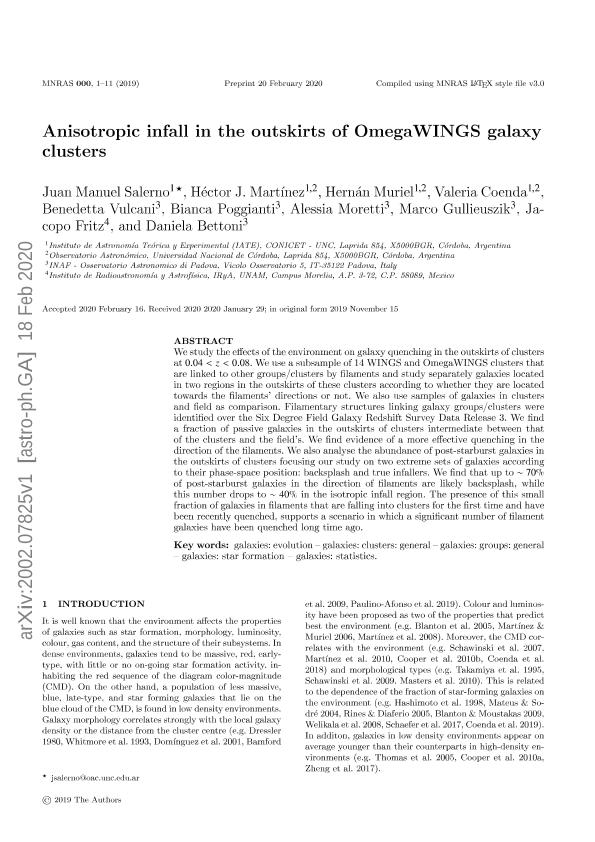Artículo
Anisotropic infall in the outskirts of OmegaWINGS galaxy clusters
Salerno, Juan Manuel ; Martínez, Héctor J.; Coenda, Valeria
; Martínez, Héctor J.; Coenda, Valeria ; Muriel, Hernan
; Muriel, Hernan ; Vulcani, B.; Poggianti, B.; Moretti, A.; Gullieuszik, M.; Fritz, J.; Bettoni, D.
; Vulcani, B.; Poggianti, B.; Moretti, A.; Gullieuszik, M.; Fritz, J.; Bettoni, D.
 ; Martínez, Héctor J.; Coenda, Valeria
; Martínez, Héctor J.; Coenda, Valeria ; Muriel, Hernan
; Muriel, Hernan ; Vulcani, B.; Poggianti, B.; Moretti, A.; Gullieuszik, M.; Fritz, J.; Bettoni, D.
; Vulcani, B.; Poggianti, B.; Moretti, A.; Gullieuszik, M.; Fritz, J.; Bettoni, D.
Fecha de publicación:
04/2020
Editorial:
Wiley Blackwell Publishing, Inc
Revista:
Monthly Notices of the Royal Astronomical Society
ISSN:
0035-8711
e-ISSN:
1365-2966
Idioma:
Inglés
Tipo de recurso:
Artículo publicado
Clasificación temática:
Resumen
We study the effects of the environment on galaxy quenching in the outskirts of clusters at 0.04 < z < 0.08. We use a subsample of 14 WINGS and OmegaWINGS clusters that are linked to other groups/clusters by filaments and study separately galaxies located in two regions in the outskirts of these clusters according to whether they are located towards the filaments´ directions or not. We also use samples of galaxies in clusters and field as a comparison. Filamentary structures linking galaxy groups/clusters were identified over the Six Degree Field Galaxy Redshift Survey Data Release 3. We find a fraction of passive galaxies in the outskirts of clusters intermediate between that of the clusters and the field´s. We find evidence of a more effective quenching in the direction of the filaments. We also analyse the abundance of post-starburst (PS) galaxies in the outskirts of clusters focusing our study on two extreme sets of galaxies according to their phase-space position: backsplash and true infallers. We find that up to ∼ 70 per cent of PS galaxies in the direction of filaments are likely backsplash, while this number drops to ∼ 40 per cent in the isotropic infall region. The presence of this small fraction of galaxies in filaments that are falling into clusters for the first time and have been recently quenched, supports a scenario in which a significant number of filament galaxies have been quenched long time ago.
Palabras clave:
Galaxias
,
Cúmulos
,
Formación Estelar
Archivos asociados
Licencia
Identificadores
Colecciones
Articulos(IATE)
Articulos de INST.DE ASTRONOMIA TEORICA Y EXPERIMENTAL
Articulos de INST.DE ASTRONOMIA TEORICA Y EXPERIMENTAL
Citación
Salerno, Juan Manuel; Martínez, Héctor J.; Coenda, Valeria; Muriel, Hernan; Vulcani, B.; et al.; Anisotropic infall in the outskirts of OmegaWINGS galaxy clusters; Wiley Blackwell Publishing, Inc; Monthly Notices of the Royal Astronomical Society; 493; 4; 4-2020; 4950-4959
Compartir
Altmétricas



